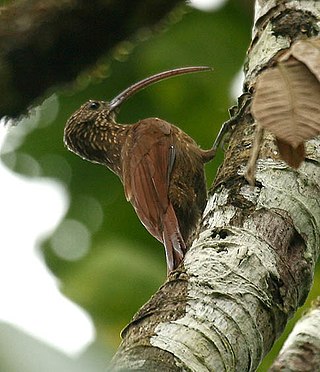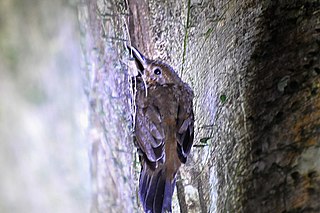
The plain-brown woodcreeper, is a sub-oscine passerine bird in subfamily Dendrocolaptinae of the ovenbird family Furnariidae. It is found in the tropical New World from Honduras through South America to central Brazil and in Trinidad and Tobago.

The buff-throated woodcreeper is a species of bird in the subfamily Dendrocolaptinae of the ovenbird family Furnariidae. It is found in Bolivia, Brazil, Colombia, Ecuador, French Guiana, Guyana, Peru, Suriname, and Venezuela.

The plain xenops is a passerine bird in the Furnariinae subfamily of the ovenbird family Furnariidae. It is found in the tropical New World from southern Mexico south as far as northern Bolivia and east across Brazil.

The streak-headed woodcreeper is a passerine bird in the subfamily Dendrocolaptinae of the ovenbird family Furnariidae. It is found in Mexico, Central America, Brazil, Colombia, Ecuador, Guyana, Peru, Venezuela, and on Trinidad.

The brown-billed scythebill is a species of bird in the subfamily Dendrocolaptinae of the ovenbird family Furnariidae. It is found in Colombia, Costa Rica, Ecuador, Panama, Peru, and Venezuela.

The red-billed scythebill is a species of bird in the subfamily Dendrocolaptinae of the ovenbird family Furnariidae. It is found in Argentina, Bolivia, Brazil, Colombia, Ecuador, Panama, Paraguay, Peru, and Venezuela.

The spot-throated woodcreeper is a species of bird in subfamily Dendrocolaptinae of the ovenbird family Furnariidae. It is found in Brazil, Colombia, Ecuador, French Guiana, Guyana, Peru, Venezuela, and possibly Suriname.

The black-banded woodcreeper is a sub-oscine passerine bird in subfamily Dendrocolaptinae of the ovenbird family Furnariidae. It is found discontinuously from Chiapas, Mexico, to Panama and in every mainland South American country except Chile and Uruguay.

The montane woodcreeper is a perching bird species in the subfamily Dendrocolaptinae of the ovenbird family Furnariidae. It is found in Bolivia, Colombia, Ecuador, Peru, and Venezuela.

The long-billed woodcreeper is a sub-oscine passerine bird in subfamily Dendrocolaptinae of the ovenbird family Furnariidae. It is found in Bolivia, Brazil, Colombia, Ecuador, French Guiana, Peru, and Venezuela.

The rufous-rumped foliage-gleaner is a species of bird in the Furnariinae subfamily of the ovenbird family Furnariidae. It is found in Bolivia, Brazil, Colombia, Ecuador, French Guiana, Guyana, Peru, and Suriname.

The rufous-tailed foliage-gleaner is a species of bird in the Furnariinae subfamily of the ovenbird family Furnariidae. It is found in Bolivia, Brazil, Colombia, Ecuador, Guyana, Peru, Suriname, Venezuela, and possibly French Guiana.

The grey-throated leaftosser is a Near Threatened species of bird in the subfamily Sclerurinae, the leaftossers and miners, of the ovenbird family Furnariidae. It is found in Bolivia, Brazil, Colombia, Costa Rica, Ecuador, Panama, Peru, Trinidad and Tobago, and Venezuela.

The short-billed leaftosser is a species of bird in the subfamily Sclerurinae, the leaftossers and miners, of the ovenbird family Furnariidae. It is found in Bolivia, Brazil, Colombia, Ecuador, French Guiana, Guyana, Peru, Suriname, and Venezuela.

The lineated foliage-gleaner is a species of bird in the Furnariinae subfamily of the ovenbird family Furnariidae. It is found in Colombia, Costa Rica, Ecuador, Panama, Peru, and Venezuela.

The slender-billed xenops is a species of bird in the Furnariinae subfamily of the ovenbird family Furnariidae. It is found in Bolivia, Brazil, Colombia, Ecuador, French Guiana, Guyana, Peru, Suriname, and Venezuela.

The elegant woodcreeper is a species of bird in the subfamily Dendrocolaptinae of the ovenbird family Furnariidae. It is found in Bolivia, Brazil, Colombia, Ecuador, and Peru.

The striped woodcreeper is a species of bird in the subfamily Dendrocolaptinae of the ovenbird family Furnariidae. It is found in Bolivia, Brazil, Colombia, Ecuador, French Guiana, Guyana, Peru, Suriname, and Venezuela.

The ocellated woodcreeper is a species of bird in the subfamily Dendrocolaptinae of the ovenbird family Furnariidae. It is found in Bolivia, Brazil, Colombia, Ecuador, Peru, and Venezuela.

The straight-billed woodcreeper is a species of bird in the subfamily Dendrocolaptinae of the ovenbird family Furnariidae. It is found in Panama, on Trindad, and in every mainland South American country except Chile, Argentina, Paraguay and Uruguay.
























